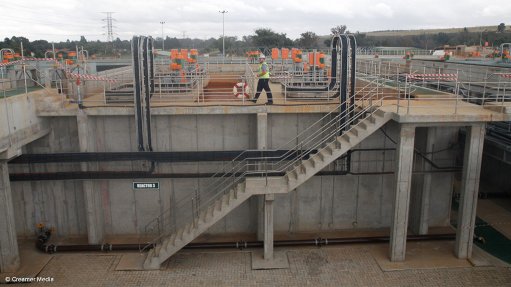
Photo by: Duane Daws
SPRINGS (miningweekly.com) – Water and Sanitation Minister Nomvula Mokonyane has lauded the successes achieved at the Eastern Basin acid mine drainage (AMD) treatment plant, in Springs, in Gauteng.
The R1-billion plant, which started operations in June 2016, was completed under the instruction of State-owned water management and project implementation authority Trans-Caledon Tunnel Authority (TCTA), as directed by the Department of Water and Sanitation (DWS). The plant is operated by industrial water treatment company Tecroveer Thanda Manzi, under the auspices of TCTA.
Speaking during a visit to the facility on Friday, the Minister highlighted that the plant formed an integral part of the of the DWS’s long-term plan to combat the challenges posed by AMD.
“The implementation of our long-term strategy will provide [environmental] security for the country’s economic hub of Gauteng,” said Mokonyane. She explained that the water treated at the plant would assist in alleviating the water constraints and improve water qualities in the Vaal river system for at least the next 30 years.
Eastern Basin plant manager Roelof van Wyk told Mining Weekly Online during the visit that the high-density sludge treatment plant was running at about 85% of its 108 Mℓ/d of AMD treatment capacity, which meant it was treating around 94 Mℓ/d of AMD.
He noted that the plant was designed to run continuously for 24 hours a day, seven days a week and comprised three heavy-duty Ritz dewatering pumps, situated 150 m below surface, with each pump pushing 1 530 m3/h of water to the surface from the old Grootvlei No 1 shaft, which extends to a depth of 1 km.
“The AMD feed is transferred to splitter box and from there it is separated across three parallel reactor circuits, which consist of preneutralisation, neutralisation and gypsum crystallisation,” Van Wyk explained.
Further, he pointed out that the plant consumed, on average, 35 t of lime a day, which was required to deliver a reasonable water quality and which is clarified in three 43 m diameter thickeners before being discharged.
“From the thickeners section of the plant, a clean overflow of water is produced and a low-quality underflow water. The underflow water is recycled back into the plant for processing purposes, while the excess sludge is disposed down Shaft 1 to a depth of 700 m below surface.”
Van Wyk noted that boreholes were currently being drilled for the mining void where the plant’s management team intended to deposit the sludge.
Meanwhile, Mokonyane stated that TCTA had been awarded a second AMD treatment phase, which would assess what was the most cost-effective and sustainable method to upgrade the AMD-treated water to a potable standard. She said the treatment options under consideration included reverse osmosis and electrocoagulation, besides others.